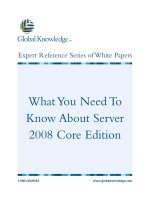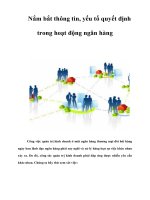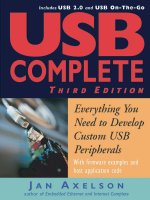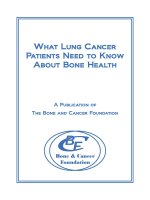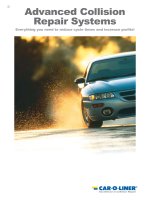Tài liệu USB Complete: Everything You Need to Develop Custom USB Peripherals (Complete Guides series) docx
Bạn đang xem bản rút gọn của tài liệu. Xem và tải ngay bản đầy đủ của tài liệu tại đây (6.85 MB, 594 trang )
USB Complete
Everything You Need
to Develop Custom USB Peripherals
Third Edition
Jan Axelson
Lakeview Research LLC
Madison, WI 53704
USB Complete: Everything You Need to Develop USB Peripherals, Third Edition
by Jan Axelson
Copyright 1999-2005 by Janet L. Axelson
All rights reserved. No part of the contents of this book, except the program code, may
be reproduced or transmitted in any form or by any means without the written permis-
sion of the publisher. The program code may be stored and executed in a computer sys-
tem and may be incorporated into computer programs developed by the reader.
The information, computer programs, schematic diagrams, documentation, and other
material in this book are provided “as is,” without warranty of any kind, expressed or
implied, including without limitation any warranty concerning the accuracy, adequacy,
or completeness of the material or the results obtained from using the material. Neither
the publisher nor the author shall be responsible for any claims attributable to errors,
omissions, or other inaccuracies in the material in this book. In no event shall the pub-
lisher or author be liable for direct, indirect, special, incidental, or consequential dam-
ages in connection with, or arising out of, the construction, performance, or other use of
the materials contained herein.
Many of the products and company names mentioned herein are the trademarks of their
respective holders. PICMicro is a registered trademark of Microchip Technology Inc. in
the U.S.A. and other countries.
Published by Lakeview Research LLC, 5310 Chinook Ln., Madison WI 53704
On the web at www.Lvr.com
Distributed by Independent Publishers Group (www.ipgbook.com).
Cover by Rattray Design. Cover Photo by Bill Bilsley Photography.
Index by Julie Kawabata.
14 13 12 11 10 9 8 7 6 5 4 3 2 1
PDF e-book edition
ISBN13 978-1-931448-03-1
ISBN10 1-931448-03-5
Contents
iii
Contents
Introduction xv
1. USB Basics 1
What USB Can Do 2
Benefits for Users 2
Benefits for Developers 6
Beyond the Hype 10
Evolution of an Interface 13
Original USB 14
USB 2.0 15
USB On-The-Go 16
Wireless USB 16
USB versus IEEE-1394 16
USB versus Ethernet 17
Bus Components 17
Topology 18
Defining Terms 19
Contents
iv
Division of Labor 22
The Host’s Duties 22
The Peripheral’s Duties 25
What about Speed? 28
Developing a Device 29
Elements in the Link 29
Tools for Developing 30
Steps in Developing a Project 30
2. Inside USB Transfers 33
Transfer Basics 34
Enumeration Communications 34
Application Communications 34
Managing Data on the Bus 35
Host Speed and Bus Speed 36
Elements of a Transfer 37
Device Endpoints: the Source and Sink of Data 38
Pipes: Connecting Endpoints to the Host 40
Types of Transfers 40
Stream and Message Pipes 42
Initiating a Transfer 43
Transactions: the Building Blocks of a Transfer 44
Transaction Phases 45
Ensuring that Transfers Are Successful 51
Handshaking 51
Reporting the Status of Control Transfers 55
Error Checking 56
3. A Transfer Type for Every Purpose 61
Control Transfers 61
Availability 62
Structure 62
Data Size 66
Speed 66
Detecting and Handling Errors 68
Bulk Transfers 68
Availability 69
Structure 69
Data Size 69
Speed 71
Detecting and Handling Errors 71
Contents
v
Interrupt Transfers 72
Availability 72
Structure 72
Data Size 73
Speed 73
Detecting and Handling Errors 75
Isochronous Transfers 76
Availability 76
Structure 76
Data Size 79
Speed 79
Detecting and Handling Errors 80
More about Time-critical Transfers 80
Bus Bandwidth 81
Device Capabilities 81
Host Capabilities 82
Host Latencies 83
4. Enumeration: How the Host Learns about Devices 85
The Process 86
Enumeration Steps 87
Enumerating a Hub 91
Device Removal 92
Tips for Successful Enumeration 92
Descriptors 93
Types of Descriptors 94
Device Descriptor 96
Device_qualifier Descriptor 99
Configuration Descriptor 101
Other_speed_configuration Descriptor 103
Interface Association Descriptor 103
Interface Descriptor 106
Endpoint Descriptor 108
String Descriptor 112
Other Standard Descriptors 113
The Microsoft OS Descriptor 114
Descriptors in 2.0-compliant Devices 114
Making 1.x Descriptors 2.0-compliant 114
Detecting the Speed of a Dual-Speed Device 116
Contents
vi
5. Control Transfers:
Structured Requests for Critical Data 117
Elements of a Control Transfer 117
Setup Stage 118
Data Stage 120
Status Stage 122
Handling Errors 124
Device Firmware 125
The Requests 127
Get_Status 129
Clear_Feature 130
Set_Feature 131
Set_Address 132
Get_Descriptor 133
Set_Descriptor 134
Get_Configuration 135
Set_Configuration 136
Get_Interface 137
Set_Interface 138
Synch_Frame 139
Other Control Requests 140
Class-specific Requests 140
Vendor-specific Requests 140
6. Chip Choices 141
Components of a USB Device 142
The USB Controller 143
Other Device Components 145
Simplifying Device Development 148
Device Requirements 149
Chip Documentation 150
Driver Choices 151
Debugging Tools 151
Controllers with Embedded CPUs 154
Microchip PIC18F4550 156
Cypress EZ-USB 157
Cypress enCoRe II 163
Freescale MC68HC908JB16 164
Freescale MCF5482 ColdFire 164
Contents
vii
Controllers that Interface to External CPUs 165
National Semiconductor USBN9603 165
Philips Semiconductors ISP1181B 167
Philips Semiconductors ISP1581 168
PLX Technology NET2272 169
FTDI Chip FT232BM and FT245BM 170
7. Device Classes 177
About Classes 177
Device Working Groups 178
Elements of a Class Specification 178
Defined Classes 181
Audio 181
Chip/Smart Card Interface 189
Communication Devices: Modems and Networks 191
Content Security 198
Device Firmware Upgrade 200
Human Interface 203
IrDA Bridge 206
Mass Storage 208
Printers 213
Still Image Capture: Cameras and Scanners 217
Test and Measurement 220
Video 221
Implementing Non-standard Functions 226
Standard or Custom Driver? 226
Converting from RS-232 227
Converting from the Parallel Port 229
PC-to-PC Communications 229
Using a Generic Driver 231
8. How the Host Communicates 233
Device Driver Basics 233
Insulating Applications from the Details 234
Options for USB Devices 235
User and Kernel Modes 235
WDM Drivers 237
Layered Drivers 238
Communication Flow 243
More Examples 246
Contents
viii
Creating a Custom Driver 247
Writing a Driver from Scratch 247
Using a Driver Toolkit 248
Using GUIDs 249
Device Setup GUIDs 250
Device Interface GUIDs 251
9. Matching a Driver to a Device 253
Using the Device Manager 253
Viewing Devices 254
Property Pages 257
Device Information in the Registry 257
The Hardware Key 258
The Class Key 259
The Driver Key 260
The Service Key 262
Inside INF Files 262
Syntax 265
Sections 266
Using Device Identification Strings 272
Finding a Match 274
Do You Need to Provide an INF File? 276
Tools and Diagnostic Aids 277
Tips for Using INF Files 277
What the User Sees 279
10. Detecting Devices 281
A Brief Guide to Calling API Functions 281
Managed and Unmanaged Code 282
Documentation 284
Using Visual C++ .NET 284
Using Visual Basic .NET 286
Finding Your Device 291
Obtaining the Device Interface GUID 292
Requesting a Pointer to a Device Information Set 293
Identifying a Device Interface 295
Requesting a Structure Containing the Device Path Name 298
Extracting the Device Path Name 301
Closing Communications 302
Contents
ix
Obtaining a Handle 303
Requesting a Communications Handle 303
Closing the Handle 306
Detecting Attachment and Removal 306
About Device Notifications 307
Registering for Device Notifications 307
Capturing Device Change Messages 311
Reading Device Change Messages 312
Retrieving the Device Path Name in the Message 314
Stopping Device Notifications 317
11. Human Interface Devices:
Using Control and Interrupt Transfers 319
What is a HID? 320
Hardware Requirements 321
Firmware Requirements 323
Identifying a Device as a HID 323
The HID Interface 326
HID Class Descriptor 326
Report Descriptors 328
HID-specific Requests 330
Get_Report 332
Get_Idle 333
Get_Protocol 334
Set_Report 335
Set_Idle 336
Set_Protocol 337
Transferring Data 338
About the Example Code 338
Sending Reports via Interrupt Transfers 340
Receiving Reports via Interrupt Transfers 343
Sending Reports via Control Transfers 345
Receiving Reports via Control Transfers 347
12. Human Interface Devices: Reports 351
Report Structure 351
Using the HID Descriptor Tool 352
Control and Data Item Values 354
Item Types 354
Contents
x
The Main Item Type 355
Input, Output, and Feature Items 356
Collection and End Collection Items 360
The Global Item Type 361
Identifying the Report 361
Describing the Data’s Use 363
Converting Units 365
Converting Raw Data 366
Describing the Data’s Size and Format 369
Saving and Restoring Global Items 369
The Local Item Type 370
Physical Descriptors 373
Padding 373
13. Human Interface Devices: Host Application 375
HID API Functions 375
Requesting Information about the HID 376
Sending and Receiving Reports 376
Providing and Using Report Data 378
Managing HID Communications 379
Identifying a Device 379
Reading the Vendor and Product IDs 380
Getting a Pointer to a Buffer with Device Capabilities 384
Getting the Device’s Capabilities 385
Getting the Capabilities of the Buttons and Values 388
Sending and Receiving Reports 388
Sending an Output Report to the Device 389
Reading an Input Report from the Device 392
Writing a Feature Report to the Device 402
Reading a Feature Report from a Device 404
Closing Communications 406
14. Bulk Transfers for Any CPU 407
Two Projects 407
Asynchronous Serial Interface 408
Parallel Interface 414
Host Programming 421
Using the D2XX Direct Driver 422
Selecting a Driver 422
Contents
xi
Performance Tips 426
Speed Considerations 426
Minimizing Latency 427
Preventing Lost Data 428
EEPROM Programming 429
EEPROM Data 429
Editing the Data 429
15. Hubs: the Link between Devices and the Host 433
Hub Basics 434
The Hub Repeater 435
The Transaction Translator 438
The Hub Controller 444
Speed 445
Maintaing an Idle Bus 447
How Many Hubs in Series? 447
The Hub Class 448
Hub Descriptors 448
Hub-class Requests 452
Port Indicators 453
16. Managing Power 455
Powering Options 455
Voltages 456
Which Peripherals Can Use Bus Power? 457
Power Needs 458
Informing the Host 459
Hub Power 461
Power Sources 461
Over-current Protection 462
Power Switching 463
Saving Power 464
Global and Selective Suspends 464
Current Limits for Suspended Devices 464
Resuming Communications 466
Power Management under Windows 467
17. Testing and Debugging 471
Tools 471
Hardware Protocol Analyzers 472
Software Protocol Analyzers 475
Traffic Generators 477
Contents
xii
Testing 477
Compliance Testing 478
WHQL Testing 484
18. Signals and Encoding 489
Bus States 489
Low-speed and Full-speed Bus States 490
High-speed Bus States 492
Data Encoding 494
Staying Synchronized 496
Timing Accuracy 498
Packet Format 499
Fields 499
Inter-packet Delay 501
Test Modes 502
Entering and Exiting Test Modes 502
The Modes 502
19. The Electrical Interface 505
Transceivers and Signals 506
Cable Segments 506
Low- and Full-speed Transceivers 508
High-speed Transceivers 512
Signal Voltages 517
Low and Full Speeds 517
High Speed 518
Cables 518
Conductors 518
Connectors 520
Detachable and Captive Cables 524
Cable Length 524
Ensuring Signal Quality 525
Sources of Noise 526
Balanced Lines 527
Twisted Pairs 527
Shielding 528
Edge Rates 529
Isolated Interfaces 529
Contents
xiii
Wireless Links 530
Cypress WirelessUSB 530
The Wireless USB Initiative 533
Other Options 534
20. Dual-role Devices with USB On-The-Go 535
Device and Host in One 536
Capabilities and Limits 536
Requirements for an OTG Device 538
The OTG Descriptor 545
Feature Codes for HNP 545
OTG Controller Chips 545
Philips ISP1362 546
TransDimension TD242LP 547
Cypress CY7C67200 EZ-OTG 548
Philips ISP1261 Bridge Controller 549
Index 551
Contents
xiv
Introduction
USB Complete xv
Introduction
This book is for developers who design and program devices that use the
Universal Serial Bus (USB) interface. My goal is to introduce you to USB
and to help you get your devices up and communicating as quickly and eas-
ily as possible.
The USB interface is versatile enough for a wide range of peripheral devices.
Standard peripherals that use USB include mice, keyboards, drives, printers,
and audio/video devices. USB is also suitable for data-acquisition units, con-
trol systems, and other devices with specialized functions, including
one-of-a-kind designs.
To develop a device with a USB interface, you need to know something
about how the interface works, what tasks your device firmware must per-
form to communicate on the bus, and what class drivers and other support
are available on the host computers that your device will attach to. The right
choices of device hardware, device class, and development tools and tech-
Introduction
xvi USB Complete
niques can go a long way in avoiding snags and simplifying what needs to be
done.
If you’re involved with designing USB devices, writing the firmware that
resides inside USB devices, or writing applications that communicate with
USB devices, this book will help you along the way.
What’s Inside
These are some of questions the book answers:
• How do USB devices communicate? The USB interface can seem daunting
at first. The USB 2.0 specification is over 600 pages, not counting the
class specifications and other supplementary documents. This book
doesn’t attempt to restate everything in the specifications. Instead, the
focus is on what you’ll need to know to enable your devices to communi-
cate efficiently and reliably.
• How can I decide if my device should use a USB interface? USB isn’t the
best choice for every application. Find out whether your design should
use USB or another interface. The chances are good that you will choose
USB, however, and if so, you’ll learn how to decide which of USB’s three
speeds and four transfer types are appropriate for your application.
• What controller chip should my device use? Every USB device must contain
an intelligent controller to implement the USB interface. Dozens of
manufacturers offer controller chips with differing architectures and abil-
ities. This book includes descriptions of popular chips and tips to help
you select a controller based on your project’s needs and your back-
ground and preferences.
• How do applications communicate with USB devices? PC applications
access a USB device by communicating with the device driver the operat-
ing system has assigned to the device. Some devices can use class drivers
that are included with Windows. Others devices require custom drivers.
This book will introduce you to the classes and will help you determine if
a defined class is appropriate for your device. If your device requires a
custom driver, you’ll learn what’s involved in writing a driver, what tools
Introduction
USB Complete xvii
can help speed up the process, and options for obtaining drivers from
other sources. Example code shows how to detect and communicate with
devices in Visual Basic .NET and Visual C++ .NET applications.
• What firmware does my device need to support USB communications? Learn
how to write device firmware that enables your device to respond to
received requests and exchange other data on the bus.
• How do I decide whether my device can use bus power or needs its own sup-
ply? Many USB devices can be powered entirely from the bus. Find out
whether your device can use bus power. Learn how to ensure that your
device meets USB’s requirement to limit the use of bus current when the
host computer suspends the bus.
• Can I connect other USB peripherals to my device? Find out how to use
USB On-The-Go to enable your device to act as a limited-capability host
that can access other USB peripherals.
• How can I ensure that my device will communicate without problems? At the
device, writing bugfree firmware requires understanding what your
device must do to meet the requirements of the USB specifications. At
the host computer, Windows must have the information needed to iden-
tify the device and locate a driver to communicate with the device. This
book has tips, example code, and information about debugging software
and hardware to help with these tasks.
To understand the material in the book, it’s helpful to have basic knowledge
in a few areas. I assume you have some experience with digital logic, applica-
tion programming for PCs and writing embedded code for peripherals. You
don’t have to know anything at all about USB.
What’s New in the Third Edition?
Since the publication of USB Complete Second Edition, much has happened
in the world of USB. Additions to the USB specifications include many
updated and expanded device-class specifications and the USB On-The-Go
supplement. Many new device-controller chips have been released. New
tools for debugging and compliance testing are available. Support for USB
Introduction
xviii USB Complete
device classes under Windows has improved. And Microsoft’s .NET Frame-
work has become a popular platform for developing host applications.
These developments prompted me to write USB Complete Third Edition.
The material is revised and updated from start to finish to reflect these and
other developments related to USB hardware and programming.
More Information, Updates, and Corrections
To find out more about developing USB devices and the software that com-
municates with them, I invite you to visit my USB Central page at Lakeview
Research’s Web site (www.Lvr.com). You’ll find code examples and links to
articles, products, tools, and other information related to developing USB
devices. If you have a suggestion, code, or other information that you’d like
me to post or link to, let me know at
Corrections and updates will also be available at www.Lvr.com. If you find
an error, please let me know and I’ll post it.
Acknowledgements
USB is too big a topic to write about without help. I have many people to
thank.
I owe a big thanks to my technical reviewers, who provided feedback that
has greatly improved the book. (With that said, every error in this book is
mine and mine alone.)
Thanks first to Paul E. Berg, MCCI Vice President, Architecture and
USB-IF Device Working Group Chair. Thanks also to David Goll of the
USB-IF’s Video Device Working Group, Lucio DiJasio and Rawin Rojvanit
of Microchip Technology, John Hyde of usb-by-example.com, Geert Knapen
of the USB-IF’s Audio Device Working Group, Walter Oney of Walter
Oney Software, and Marc Reinig of System Solutions.
Introduction
USB Complete xix
Others I want to thank for their support are Glenn M. Roberts of Cypress
Semiconductor, Fred Dart and Keith Dingwall of FTDI Chip, Wendy Dee
of Keil Software, Michael DeVault of DeVaSys Embedded Systems, Alan
Lowne of Saelig Company Inc., Laurent Guinnard of Ellisys, Rich Moran of
RPM Systems Corporation, and Bob Nathan of NCR Corporation.
For help and support with the previous editions that this edition builds on,
thanks to Joshua Buergel, Gary Crowell, Dave Dowler, Mike Fahrion, John
M. Goodman, Lane Hauck, David James, Christer Johansson, Kosta
Koeman, Jon Lueker, Brad Markisohn, Amar Rajan, Robert Severson, Craig
R. Smith, and Dave Wright.
I hope you find the book useful. Comments invited!
Jan Axelson
Introduction
xx USB Complete
USB Basics
USB Complete 1
1
USB Basics
What if you had the chance to design a peripheral interface from scratch?
Your wish list would likely include these qualities:
• Easy to use, so there’s no need to fiddle with configuration and setup
details.
• Fast, so the interface doesn’t become a communications bottleneck.
• Reliable, so that errors are rare, with automatic retries when errors occur.
• Versatile, so many kinds of peripherals can use the interface.
• Inexpensive, so manufacturers and users don’t balk at the price.
• Power-conserving, to save energy and extend battery life in portable com-
puters and devices.
• Supported by the Windows and other operating systems, so developers
don’t have to write low-level drivers to communicate with the peripher-
als.
Chapter 1
2 USB Complete
The Universal Serial Bus (USB) has all of these qualities. USB was designed
from the ground up to be an interface for communicating with many types
of peripherals without the limits and frustrations of older interfaces.
Every recent PC and Macintosh computer includes USB ports that can con-
nect to standard peripherals such as keyboards, mice, scanners, cameras,
printers, and drives as well as custom hardware for just about any purpose.
This chapter introduces USB, including its advantages and limits, some his-
tory about the interface and recent enhancements to it, and a look at what’s
involved in designing and programming a device with a USB interface.
What USB Can Do
USB is a likely solution any time you want to use a computer to communi-
cate with a device outside of the computer. The interface is suitable for
mass-produced, standard peripheral types as well as small-volume designs,
including one-of-a-kind projects.
To be successful, an interface has to please two audiences: the users who
want to use the peripherals and the developers who design the hardware and
write the code that communicates with the device. USB has features to
please both.
Benefits for Users
From the user’s perspective, the benefits of USB are ease of use, fast and reli-
able data transfers, flexibility, low cost, and power conservation. Table 1-1
compares USB with other popular interfaces.
Ease of Use
Ease of use was a major design goal for USB, and the result is an interface
that’s a pleasure to use for many reasons:
One interface for many devices. USB is versatile enough to be usable with
a variety of peripheral types. Instead of having a different connector type
and supporting hardware for each peripheral, one interface serves many.
USB Basics
USB Complete 3
Table 1-1: Comparison of popular computer interfaces. Where a standard
doesn’t specify a maximum, the table shows a typical maximum.
Interface Format Number of
Devices
(maximum)
Distance
(maximum,
feet)
Speed
(maximum,
bits/sec.)
Typical Use
USB asynchronous
serial
127 16 (up to 96
ft. with 5
hubs)
1.5M, 12M,
480M
Mouse,
keyboard, drive,
audio, printer,
other standard
and custom
peripherals
Ethernet serial 1024 1600 10G General network
communications
IEEE-1394b
(FireWire 800)
serial 64 300 3.2G Video, mass
storage
IEEE-488
(GPIB)
parallel 15 60 8M Instrumentation
IrDA asynchronous
serial infrared
2 6 16M Printers, hand-
held computers
I
2
C
synchronous
serial
40 18 3.4M Microcontroller
communications
Microwire synchronous
serial
8 10 2M Microcontroller
communications
MIDI serial current
loop
2 (more with
flow-through
mode)
50 31.5k Music, show
control
Parallel Printer
Port
parallel 2 (8 with
daisy-chain
support)
10–30 8M Printers,
scanners, disk
drives
RS-232
(EIA/TIA-232)
asynchronous
serial
2 50-100 20k (115k
with some
hardware)
Modem, mouse,
instrumentation
RS-485
(TIA/EIA-485)
asynchronous
serial
32 unit loads
(up to 256
devices with
some
hardware)
4000 10M Data acquisition
and control
systems
SPI synchronous
serial
8 10 2.1M Microcontroller
communications
Chapter 1
4 USB Complete
Automatic configuration. When a user connects a USB peripheral to a PC,
Windows detects the peripheral and loads the appropriate software driver.
The first time the peripheral connects, Windows may prompt the user to
insert a disk with driver software, but other than that, installation is auto-
matic. There’s no need to restart the system before using the peripheral.
Easy to connect. With USB, there’s no need to open the computer’s enclo-
sure to add an expansion card for each peripheral. A typical PC has four or
more USB ports. You can expand the number of ports by adding hubs with
additional ports.
Easy cables. USB cable connectors are keyed so you can’t plug them in
wrong. A cable segment can be as long as 5 meters. With hubs, a peripheral
can be as far as 30 meters from its host PC. USB connectors are small and
compact in contrast to typical RS-232 and parallel connectors. To ensure
reliable operation, the USB specification includes detailed requirements that
all cables and connectors must meet.
Hot pluggable. You can connect and disconnect a USB peripheral when-
ever you want, whether or not the system and peripheral are powered, with-
out damaging the PC or device. The operating system detects when a
peripheral is attached and readies it for use.
No user settings. USB peripherals don’t have user-selectable settings such as
port addresses and interrupt-request (IRQ) lines so there are no jumpers to
set or configuration utilities to run.
Frees hardware resources for other devices. Using USB for as many
peripherals as possible frees up IRQ lines for the peripherals that require
them. The PC dedicates a series of port addresses and one IRQ line to the
USB host controller, but individual peripherals don’t require additional
resources or any PC programming that involves specifying port addresses or
detecting hardware interrupts. In contrast, peripherals with other interfaces
may require dedicated port addresses, an IRQ line, and an expansion slot.
No power supply required (sometimes). The USB interface includes
power-supply and ground lines that provide a nominal +5V from the com-
puter’s or hub’s power supply. A peripheral that requires up to 500 milliam-
peres can draw all of its power from the bus instead of having to provide a
